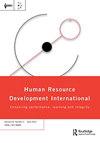远程工作和工作与生活的平衡:从新冠肺炎大流行中吸取的教训和对人力资源开发从业者的建议
IF 3.8
Q2 MANAGEMENT
引用次数: 57
摘要
摘要远程工作的流行表现通常将其描述为一种灵活、技术可行、适合家庭的工作安排。远程工作作为一种理想的工作安排的形象是否受到新冠肺炎大流行的挑战?在这段时间里,我们从许多员工普遍的非自愿远程工作中学到了什么?为了回答这些问题,我们分析了最近的40项实证研究,这些研究考察了疫情期间在家工作时的工作与生活平衡。我们的分析以人-环境适合理论为依据,并辅以疫情前进行的远程工作文献综述。我们发现四个主题代表了远程工作的理想期望和不理想现实之间的不匹配:(1)弹性工作时间与工作强度,(2)弹性工作地点与空间限制,(3)技术上可行的工作安排与。技术压力和孤立,以及(4)家庭友好型工作安排与家务劳动和护理强度。我们强调了人力资源开发从业者在帮助员工实现远程工作期望和体验之间的匹配方面可以发挥的重要作用。本文章由计算机程序翻译,如有差异,请以英文原文为准。
Remote work and work-life balance: Lessons learned from the covid-19 pandemic and suggestions for HRD practitioners
ABSTRACT Popular representations of remote work often depict it as a flexible, technologically feasible, and family-friendly work arrangement. Have the images of remote working as a desirable work arrangement been challenged by the COVID-19 pandemic? What have we learned from the widespread involuntary remote work imposed on many employees during this time? To answer these questions, we analysed 40 recent empirical studies that examined work-life balance while working from home during the pandemic. Our analysis was informed by the person-environment fit theory and complemented by literature reviews on remote work conducted prior to the pandemic. We found four themes representing misfits between desirable expectations and the undesirable realities of remote work: (1) flextime vs. work intensity, (2) flexplace vs. space limitation, (3) technologically-feasible work arrangementvs. technostress and isolation, and (4) family-friendly work arrangement vs. housework and care intensity. We highlight the important role HRD practitioners can play in assisting employees to achieve a fit between their expectations and experiences of remote work.
求助全文
通过发布文献求助,成功后即可免费获取论文全文。
去求助
来源期刊

HUMAN RESOURCE DEVELOPMENT INTERNATIONAL
MANAGEMENT-
CiteScore
11.40
自引率
11.10%
发文量
43
期刊介绍:
Human Resource Development International promotes all aspects of practice and research that explore issues of individual, group and organisational learning and performance. In adopting this perspective Human Resource Development International is committed to questioning the divide between practice and theory; between the practitioner and the academic; and between traditional and experimental methodological approaches. Human Resource Development International is committed to a wide understanding of ''organisation'' - one that extends through self-managed teams, voluntary work, or family businesses to global enterprises and bureaucracies. Human Resource Development International also commits itself to exploring the development of organisations and the life-long learning of people and their collectivity (organisation), their strategy and their policy, from all parts of the world. In this way Human Resource Development International will become a leading forum for debate and exploration of the interdisciplinary field of human resource development.
 求助内容:
求助内容: 应助结果提醒方式:
应助结果提醒方式:


